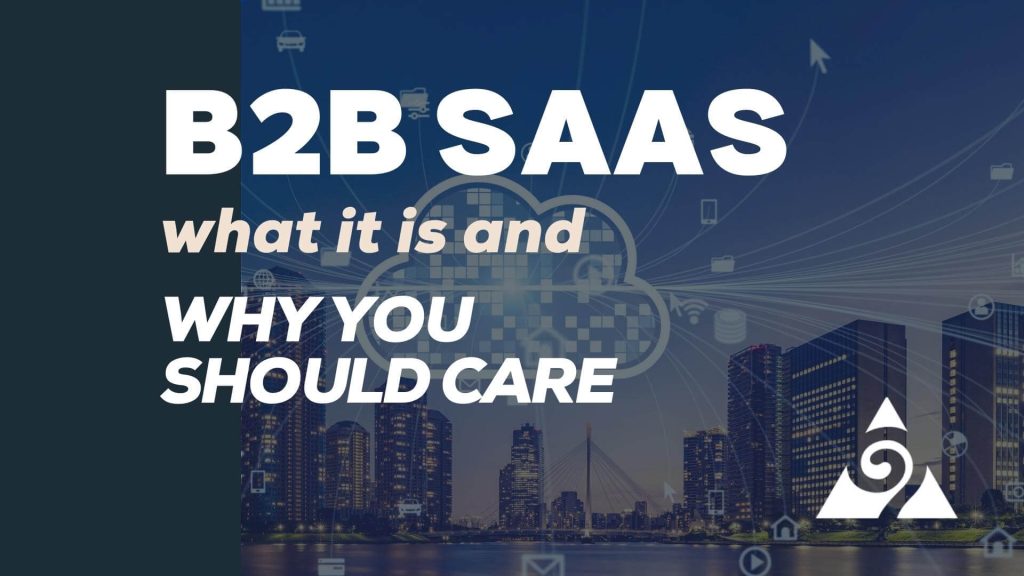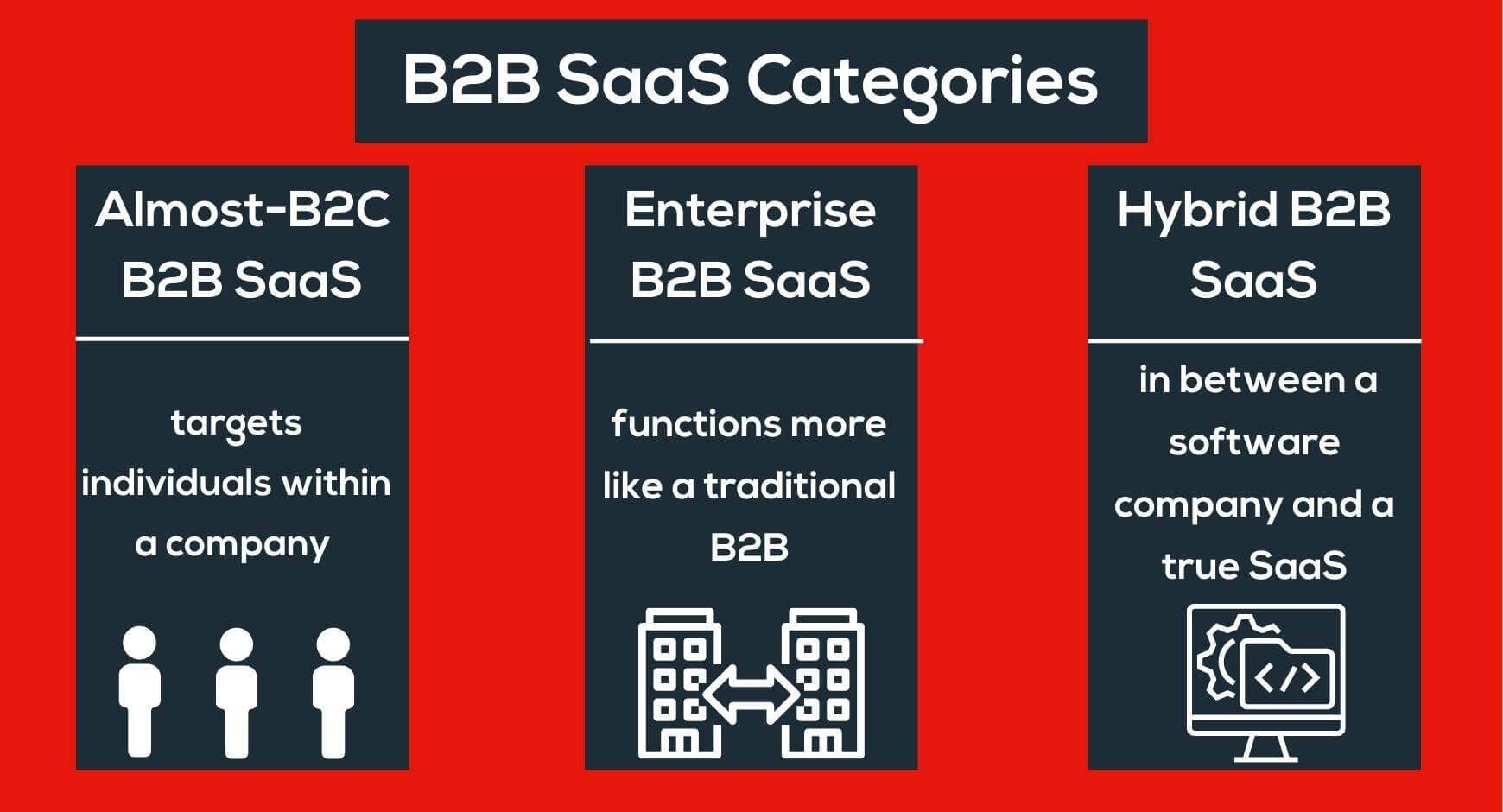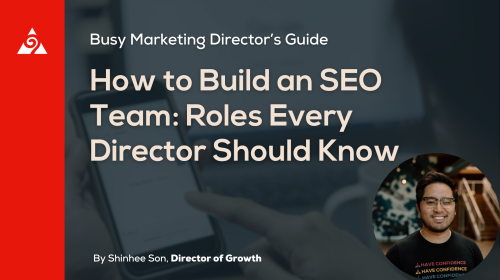What is a B2B SaaS company? What is B2B SaaS marketing, and how does it differ from traditional marketing? How can a company grow within the B2B SaaS industry? We’ll discuss all of that and more in this article.
The B2B SaaS market is booming, and with the right strategies and tools in place, your business can quickly climb the ranks to become a leader in your niche. With a firm understanding of the customer journey, you’ll increase your retention and customer loyalty. Keep reading to see how effective marketing can grow your SaaS.
Looking for more great SaaS news and advice? Sign up for our newsletter, SaaS Scoop.
What is B2B SaaS?
What are SaaS and B2B? Business to Business Software as a Service, better known as B2B SaaS, is a service offered typically through a subscription. These cloud-based services mean that the end-user at the purchasing company can access the services online, anytime, and anywhere. The goal of B2B SaaS is to solve a company’s problem, whether it be difficulty attracting new customers or struggling to retain current customers.
Without a successful marketing strategy, the right customer base won’t be targeted, resulting in missed revenue. At the other end of B2B, the customer interaction doesn’t end after the point of sale. Continual market research, engagement, and service enhancements are necessary to build brand loyalty.
B2B SaaS Model
What does a B2B software company do? B2B SaaS provides a service to other businesses to solve a specific problem or contribute to the company’s growth. The B2B SaaS model is typically subscription based, meaning that customers will pay on a monthly or annual fee plan for the software or service.
What is B2B software? Software offered through this model is cloud-based and doesn’t require physical software to be installed. This means that customers and users can access the service from any computer.
The cloud-based model gives B2B providers a considerable advantage by allowing them to focus on enhancements and new features, thanks to the consistent revenue stream. This makes their business scalable and creates brand loyalty. Growth and brand loyalty don’t come easy. Without a firm marketing strategy, it’s easy to miss out on potential customers.
Here are a few tips to ensure success in B2B SaaS:
- Marketing strategy: Have a marketing plan to drive engagement, including strong content and SEO.
- Offer a free plan: Offer some form of the platform or service for free. Let your prospects see what it’s all about.
- Analytics: Track your data, including PPCs, link clicks, and customer interactions through chat and calls.
B2B SaaS vs B2C SaaS
Now that you understand the B2B SaaS meaning, we’ll touch on B2C. B2B SaaS and B2C SaaS have many differences. B2C, or Business to Consumer, targets the everyday user rather than startups and businesses. Their business models are similar, but marketing, customer relationships, and pricing are handled very differently.
B2B products and services have more advanced features and are intended to be scalable for their customers. B2C, on the other hand, tends to be sold at a lower price point, and many consumers may be more interested in starting with the “free” model without the added advanced features.
- B2B: B2B provides scalable solutions to businesses, both large and small, that are intended to solve a problem or improve upon existing services and processes.
- B2C: B2C targets the everyday consumer, providing a free or subscription-based service, such as Photoshop or Zoom.
B2B SaaS Categories
There are many different B2B SaaS categories, and each may have different marketing and content strategies depending on its model and target customer. Some categories may focus on enterprise-level clients, while others focus on small businesses and individuals. While there are numerous categories, we’ll focus on the three main tiers in this article.
Almost-B2C B2B SaaS
Almost-B2C B2B SaaS is one of the three main categories. These companies tend to lean more toward B2C than B2B. This is because these services are sold targeting individuals within a company rather than groups or teams within that company.
These companies typically offer many pricing tiers from free to advanced to attract everyday users that may need it on a small scale or only for basic functions. Unlike enterprise or even hybrid, it would be rare for a sales team to be involved in this category of B2B SaaS.
How do Almost-B2Cs make sales? Marketing is handled through social media and other content targeted to users in that industry.
Effective marketing strategies such as an Almost-B2C will typically lead directly to a free trial, signing up for the free plan (if offered), or even leading directly to a sale. This is with minimal, if any, communication between the company and consumer. A few examples of this category include:
- Zoom
- Shopify
- Mailchimp
Enterprise B2B SaaS
B2B enterprise SaaS functions more like a traditional B2B. Their customer target is large organizations. Once in use, their service becomes a fixture, and it is difficult and resource-heavy for the company to migrate to a competitor’s product. This is due to the customizations offered and number of users at the company using the service.
The enterprise B2B SaaS platform sales process is lengthy due to the size of companies they’re targeting. Through demos, the sales process, and finally, implementation, there are many steps to selling at an enterprise level. It can take months for the product or service to launch within the customer’s organization.
Subscriptions are typically monthly or annual. In many cases, the company will purchase licenses based on the number of users. Here are a few Enterprise B2B SaaS examples:
- Salesforce
- Oracle
- SAP
Hybrid B2B SaaS
What is the hybrid B2B SaaS model? Hybrids are somewhere in between a software company and a true SaaS. They offer a software version of their product and a SaaS version.
Hybrid B2B software services have proven valuable to customers in the flexibility and scalability that these cloud services provide. As a result, many hybrid companies are shifting to become genuine B2B SaaS companies. Others find that keeping one foot in the door makes them just as attractive to prospects.
Can companies with both software and SaaS offerings be successful? They certainly can be, and many companies thrive in this hybrid category. A few of these companies are:
- Microsoft
- AdobeUnaware
- Google Suite
B2B SaaS Marketing Tips
Marketing in SaaS B2B has many differences from traditional marketing. This is due primarily to the product’s cloud-based nature and the competitive SaaS market. What is B2B SaaS marketing, and how can it be successful?
SaaS marketing is interactive and data-driven. A B2B SaaS prospect will not likely purchase a product without trying it out first. Free trials are imperative in SaaS marketing. Then data comes into the mix.
What pages and links are your current customers and site visitors using? Are they leaving your web page with little interaction? Take a look at these marketing tips to ensure growth and retention.
Refine Your Call-to-Action
A call-to-action, or CTA, is a must-use marketing tool for your website and content. Why is a CTA so important for B2B SaaS products? It encourages engagement from users by giving them a clear direction on the next step they should take. Without this, it may be unclear or overwhelming, resulting in users clicking away from the webpage.
The most effective CTAs prompt users to sign up for a free trial or even a free version of the service. The CTA may be a link in an article, or it could be a button on a web page. Keep in mind that including a CTA is essential for the following reasons:
- Provides clear direction for users to follow
- Encourages engagement
- Motivates users to try out the free trial
Leverage the Customer Journey
It’s important not to forget about the customer journey when marketing. The journey doesn’t simply start and stop with a sale. The B2B SaaS experience can be a long road for customers, and it’s important to note that it does not end after purchase and delivery. Depending on the B2B SaaS solution, a prospect may be in the awareness and consideration phases for months.
There are five phases in the customer journey: awareness, consideration, purchase, retention, and advocacy. Incorporating each of the customer journey phases into your marketing strategy is important for many reasons, including:
- Presenting a solution to an issue the user is facing
- Providing options and a direction for the user such as different pricing tiers and free trials
- Continually enhancing products and features to meet the needs and retain customers
Marketing Doesn’t End at the Sale
Once the purchase has been finalized, the customer journey doesn’t stop. Retention is just as necessary. Building brand loyalty ensures that customers don’t jump ship.
How can you build customer relationships to ensure long-term retention? The key to success is gathering data on how customers interact with your product.
With this data, you can find additional solutions or enhance the product to solve any pain points customers may be experiencing. Check-in with your customers and be their advocate to build trust.
This could be through tools such as campaigns and surveys. Use customer behaviors to send them personalized marketing and CTAs. Continuing to market to customers after the sale:
- Creates brand loyalty
- Improves customer retention
- Provides opportunities to improve products and services
B2B SaaS Retention Metrics to Track
Regarding customer retention, data will tell a story of how users interact with marketing efforts. With an effective strategy, you’ll see increased traffic and revenue. These metrics may be measured monthly, quarterly, or annually. Here are five must-use retention metrics:
- Customer Retention Rate: Are your customers loyal to your B2B SaaS? The customer retention rate is one way to measure this. Here is the equation:
Customer retention rate = (The number of customers at the end of a given period – new customers gained during that period) / The total number of customers at the start of that same period.
- Monthly Recurring Revenue (MRR): Revenue should be a given to track for any B2B, but MRR can give you a clear vision of your customer retention. MRR accounts for your monthly revenue from subscriptions based on the number of active subscribers.
- Churn: Churn is the number of customers or revenue lost in a given period. The lower the churn rate, the better because this means that your customers are satisfied.
- Lifetime Value (LTV): LTV is the average dollar amount a customer spends. LTV can be calculated with the following formula:
Customer lifetime value = ARPA / Monthly user churn rate
- Net Promoter Score (NPS): NPS measures overall customer satisfaction on a scale from 0-10 based on how likely they are to recommend your company or service. The score is then broken into one of three categories:
- Detractor
- Passive
- Promoter
Top B2B SaaS Companies
We’ve covered what B2B SaaS technology is and the importance of an effective marketing strategy. Now, let’s look at some companies that have put these tools into action, building high customer retention and revenue. Here are five successful brands in the B2B SaaS market.
Slack
Slack is a well-known name in companies both big and small around the world. They have provided a way for co-workers to stay connected while working remotely or traveling. This chat service allows co-workers to create 1:1 chats and channels that enable a larger group and even an entire company to be part of the conversation.
Slack offers four tiers of service, from a free plan to an enterprise plan. While the free option has limitations that the paid plans don’t, it allows small businesses to try out the service thoroughly. Slack can then target the customers on a free plan to upsell or add-on services to better fit their needs.
SEMrush
SEMrush found an answer to the problem many companies face – managing marketing campaigns. These campaigns can significantly aid the growth of a B2B SaaS by targeting new markets and ensuring that the campaigns are effective by measuring clicks and other metrics.
SEMrush offers comprehensive tools and features, including SEO and content marketing. Thanks to their marketing strategy and tiered pricing approach, they’ve become a success. They offer three tiers of pricing based on company size and a free trial for the first two tiers. Additionally, a free version with limited tools is available.
Google Workspace
Google is a name we’ve all heard of and have interacted with in one way or another. From an email service to forms, surveys, and docs, Google is truly a one-stop shop approach for productivity and analytical tools from an individual plan and up to B2B enterprise solutions. They offer B2B SaaS applications for just about every business need, including meetings, analytics, and an array of productivity tools.
Many of their tools are free for individuals, though a paid individual subscription is still offered with added services. For use among a team or companies of any size, Google Workspace offers many pricing tiers, including tiers within tiers for businesses.
Microsoft Office 365
Microsoft, like Google, is practically a household name offering several B2B software products. Microsoft Office 365 is Microsoft’s answer to the growing need for flexibility and cloud-based services. Productivity programs like Word, Excel, and PowerPoint are helpful for both individuals and businesses. Other programs such as SharePoint and CRM are essential to large organizations.
Microsoft offers a one-month free trial for each service tier so that customers can choose the right fit for their needs. Monthly and yearly subscription fees are offered for individual and business plans.
Hubspot
Hubspot’s B2B SaaS offering is explicitly geared toward marketing and sales. Their platform provides customers with a single source for marketing tools, including CMS, SEO, and analytics. All of which are essential to a successful B2B SaaS marketing strategy.
What has made Hubspot a successful SaaS provider? Many free marketing tools they offer require no subscription. It allows users to get a feel for what Hubspot has to offer. These users are potential prospects for upselling to a higher paid tier or a services bundle to suit their needs better.
Partner with Augurian to Grow Your B2B SaaS Business
The B2B SaaS market is competitive. On the flip side, B2B SaaS solutions are growing in demand. It’s important to remember that marketing efforts cannot stop with the sale.
Brand loyalty cannot be achieved if a customer does not feel heard in their feedback and needs. Without a firm understanding of what the customer journey looks like for your solutions, marketing will be ineffective, and you’ll risk missing out on customers and, ultimately, revenue.
We will customize a marketing strategy that will benefit your company, whether you’re established in the market or a startup. Explore our digital marketing services for SaaS and B2B, and get in touch with us today!







